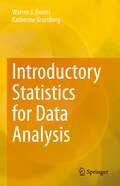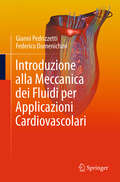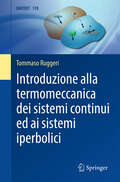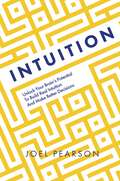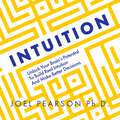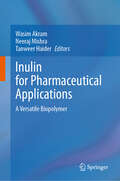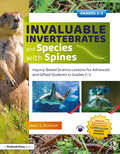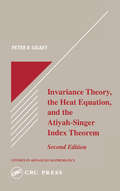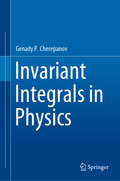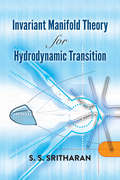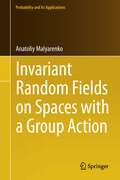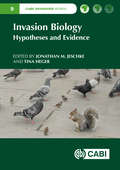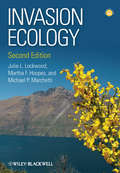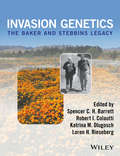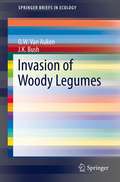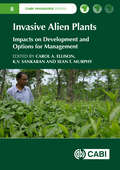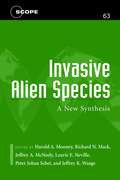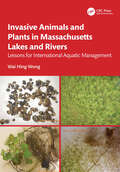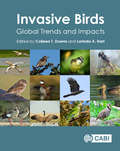- Table View
- List View
Introductory Statistics for Data Analysis
by Warren J. Ewens Katherine BrumbergThis book describes the probability theory associated with frequently used statistical procedures and the relation between probability theory and statistical inference. The first third of the book is dedicated to probability theory including topics relating to events, random variables, and the Central Limit Theorem. Statistical topics then include parameter estimation with confidence intervals, hypothesis testing, chi-square tests, t tests, and several non-parametric tests. Flow charts are frequently used to facilitate an understanding of the material considered. The examples and problems in the book all concern simple data sets which can be analyzed with a simple calculator; however, the R code required to complete many examples and problems is provided as well for those that are interested.
Introductory Textbook of Psychiatry (Fifth Edition)
by Donald W. Black Nancy C. AndreasenLearn more about psychiatric diagnosis and therapy.
Introduzione alla Meccanica dei Fluidi per Applicazioni Cardiovascolari
by Gianni Pedrizzetti Federico DomenichiniQuesto libro parte da una descrizione degli elementi fondamentali della meccanica dei fluidi nei grandi vasi sanguigni. A questo fine, viene introdotto un rigoroso background fisico accompagnato da esempi applicati alla circolazione, presentando risultati classici e sviluppi recenti relativi allo studio della dinamica sanguigna nella fisiologia cardiovascolare. Esplora poi argomenti più avanzati per una comprensione dei fenomeni, effettivamente riscontrati in cardiologia clinica, fondata sull’utilizzo delle leggi di conservazione della meccanica. Il testo si presenta come una risorsa di apprendimento ideale per fisici e ingegneri che si occupano di dinamica dei fluidi cardiovascolare, operatori nel settore delle tecnologie biomediche, studenti in biofluidodinamica. Il libro fornisce un filo conduttore tra i campi distanti della meccanica dei fluidi e della cardiologia clinica. Ben radicato nella teoria della dinamica dei fluidi, guida il lettore attraverso scenari progressivamente più realistici fino alla complessità delle applicazioni mediche di routine. Basato su oltre 25 anni di collaborazioni dell'autore con i cardiologi, aiuta gli ingegneri a imparare a comunicare con i clinici, mantenendo al contempo il rigore delle discipline scientifiche. Scritto in uno stile conciso, è un libro di testo accessibile a un ampio pubblico di lettori, tra cui studenti, fisici e ingegneri, offrendo un punto di ingresso a questo campo multidisciplinare. Include concetti chiave esemplificati da illustrazioni che utilizzano tecniche di analisi di immagini all'avanguardia e da riferimenti a metodi di modellazione e misurazione, e contiene intuizioni originali uniche.
Introduzione alla termomeccanica dei sistemi continui ed ai sistemi iperbolici (UNITEXT #170)
by Tommaso RuggeriL'obiettivo principale di questo libro è presentare un trattamento unificato della termomeccanica dei continui utilizzando l'approccio assiomatico tipico della meccanica razionale. Mentre molti testi di meccanica dei continui si concentrano su tipi specifici di corpi continui, come i corpi solidi deformabili o i fluidi, questo libro adotta una prospettiva generale. Viene presentata la struttura matematica delle leggi di bilancio e delle equazioni costitutive come un insieme coeso, con particolare attenzione alla moderna teoria delle equazioni costitutive. Si sottolineano principi importanti, come il principio di indifferenza materiale e l'interpretazione contemporanea del principio di entropia. Per garantire la coerenza interna, la prima parte del libro affronta questioni relative all'algebra lineare, con particolare attenzione agli operatori lineari all'interno degli spazi vettoriali a dimensione finita. Successivamente, il libro offre un'esplorazione dettagliata delle deformazioni finite dei continui, seguita da una panoramica sulla cinematica. Vengono caratterizzate le varie forze che possono esistere in un continuo, introdotto il tensore degli sforzi e presentate le leggi di bilancio sia in forma euleriana che lagrangiana. Successivamente viene definita la moderna teoria delle equazioni costitutive, sottolineando il ruolo dei principi generali di indifferenza materiale e di entropia come criteri per la selezione delle classi fisicamente accettabili di equazioni costitutive. Le equazioni di campo risultanti sono specializzate per vari casi, tra cui la termoelasticità, i fluidi euleriani, i fluidi di Fourier-Navier‒Stokes e i conduttori rigidi di calore. Nell'ultima parte del libro vengono discussi i sistemi di equazioni alle derivate parziali nella meccanica dei continui, con particolare attenzione ai sistemi iperbolici. Il metodo delle caratteristiche viene introdotto sia nei casi lineari che non lineari, e si discute la necessità di ampliare la classe delle soluzioni introducendo le soluzioni deboli, con le onde d'urto come caso significativo. Come esempio illustrativo di soluzione debole, viene presentato il problema di Riemann per il modello fluidodinamico del traffico veicolare, in cui le automobili sono inizialmente ferme a un semaforo rosso e poi iniziano a muoversi quando il semaforo diventa verde. Questo libro sarà utile non solo per gli studenti di ingegneria, ma anche per gli studenti di altre discipline scientifiche in cui si studiano aspetti della meccanica dei continui. Fornisce l'opportunità di considerare argomenti tradizionalmente distinti in un contesto più ampio e interconnesso.
Intuition: Unlock Your Brain's Potential to Build Real Intuition and Make Better Decisions
by Joel PearsonWe have all experienced a 'gut reaction' or acted 'on a hunch' – we've used our intuition.Until recently, science didn't have a good explanation for how intuition works. In fact, some scientists dismissed it altogether as unproveable and 'woo woo'.Here, in the first book to explain the science behind intuition, Professor Joel Pearson, an expert in cognitive neuroscience and leader in human consciousness research, turns what we think we know about intuition on its head.At his dedicated lab at Sydney's prestigious University of New South Wales, Pearson was able to identify and recreate intuition in a lab, proving its existence and laying the groundwork for this book – a practical and entertaining introduction to the brain science underpinning intuition, and a framework for how we can develop the ability and put it to use, in the boardroom and beyond.Intuition follows basic rules, and Pearson explains that by understanding them, we can better train ourselves to use our intuition productively, supercharging this incredible human ability and harnessing it toward better decision-making.Intuition is not a sixth sense – it's a superpower.
Intuition: Unlock Your Brain's Potential to Build Real Intuition and Make Better Decisions
by Joel PearsonWe have all experienced a 'gut reaction' or acted 'on a hunch' – we've used our intuition.Until recently, science didn't have a good explanation for how intuition works. In fact, some scientists dismissed it altogether as unproveable and 'woo woo'.Here, in the first book to explain the science behind intuition, Professor Joel Pearson, an expert in cognitive neuroscience and leader in human consciousness research, turns what we think we know about intuition on its head.At his dedicated lab at Sydney's prestigious University of New South Wales, Pearson was able to identify and recreate intuition in a lab, proving its existence and laying the groundwork for this book – a practical and entertaining introduction to the brain science underpinning intuition, and a framework for how we can develop the ability and put it to use, in the boardroom and beyond.Intuition follows basic rules, and Pearson explains that by understanding them, we can better train ourselves to use our intuition productively, supercharging this incredible human ability and harnessing it toward better decision-making.Intuition is not a sixth sense – it's a superpower.
Intuition: Unlock Your Brain's Potential to Build Real Intuition and Make Better Decisions
by Joel PearsonWe have all experienced a 'gut reaction' or acted 'on a hunch' – we've used our intuition.Until recently, science didn't have a good explanation for how intuition works. In fact, some scientists dismissed it altogether as unproveable and 'woo woo'.Here, in the first book to explain the science behind intuition, Professor Joel Pearson, an expert in cognitive neuroscience and leader in human consciousness research, turns what we think we know about intuition on its head.At his dedicated lab at Sydney's prestigious University of New South Wales, Pearson was able to identify and recreate intuition in a lab, proving its existence and laying the groundwork for this book – a practical and entertaining introduction to the brain science underpinning intuition, and a framework for how we can develop the ability and put it to use, in the boardroom and beyond.Intuition follows basic rules, and Pearson explains that by understanding them, we can better train ourselves to use our intuition productively, supercharging this incredible human ability and harnessing it toward better decision-making.Intuition is not a sixth sense – it's a superpower.
Inulin for Pharmaceutical Applications: A Versatile Biopolymer
by Neeraj Mishra Wasim Akram Tanweer HaiderThis book explores the different uses of inulin in pharmaceutical formulations, its potential therapeutic benefits, and the regulatory considerations involved in developing inulin-based pharmaceutical products. The book covers topics such as the physical and chemical properties of inulin, its use in drug delivery and controlled release systems, therapeutic applications in managing metabolic disorders, gastrointestinal disorders, immune function, bone health, and brain health, as well as the regulatory considerations involved in developing inulin-based pharmaceutical products. The book aims to provide a complete understanding of the various applications of inulin in the pharmaceutical industry, making it relevant and significant for pharmaceutical professionals seeking to develop new drugs and drug delivery systems. Additionally, it provides valuable information for researchers and scientists working on inulin-based treatments and formulations. It appears to be a comprehensive guide for scientists, researchers, and pharmaceutical professionals interested in understanding the various applications of inulin in the pharmaceutical industry.
Invaders
by Rob HaleThis fifth grade reading series introduces readers to ecology, global environment and the costly mistakes importation of non-native species have on the global ecology. "Invaders" seeks to educate its young readers to think carefully about how even small actions may have devastating effects on global animal and plant habitats.
Invaluable Invertebrates and Species with Spines: Inquiry-Based Science Lessons for Advanced and Gifted Students in Grades 2-3
by Jason S. McIntoshRecipient of the 2022 NAGC Curriculum AwardInspire the next generation of zoologists with this 30-lesson interdisciplinary science unit geared toward second and third grade high-ability students.Using problem-based learning scenarios, this book helps students develop the vocabulary, skills, and practices of zoologists as they conduct research and solve real world problems. Students will gain an in-depth understanding of how the animal kingdom is structured, create an innovative zoo exhibit containing an entire ecosystem for a vertebrate animal of their choosing, design invertebrate animal trading cards, and much, much more. Featuring detailed teacher instructions and reproducible handouts, this unit makes it easy for teachers to adjust the rigor of learning tasks based on students’ interests and needs.Aligned with Common Core State Standards for English Language Arts and Mathematics plus the Next Generation Science Standards, gifted and non-gifted teachers alike will find this expedition into the animal kingdom engaging, effective, and highly adaptable.
Invariance Theory: The Heat Equation and the Atiyah-Singer Index Theorem (Studies in Advanced Mathematics #16)
by Peter B. GilkeyThis book treats the Atiyah-Singer index theorem using the heat equation, which gives a local formula for the index of any elliptic complex. Heat equation methods are also used to discuss Lefschetz fixed point formulas, the Gauss-Bonnet theorem for a manifold with smooth boundary, and the geometrical theorem for a manifold with smooth boundary. The author uses invariance theory to identify the integrand of the index theorem for classical elliptic complexes with the invariants of the heat equation.
Invariant Integrals in Physics
by Genady P. CherepanovIn this book, all physical laws are derived from a small number of invariant integrals which express the conservation of energy, mass, or momentum. This new approach allows us to unify the laws of theoretical physics, to simplify their derivation, and to discover some novel or more universal laws. Newton's Law of gravity is generalized to take into account cosmic forces of repulsion, Archimedes' principle of buoyancy is modified for account of the surface tension, and Coulomb's Laws for rolling friction and for the interaction of electric charges are substantially repaired and generalized. For postgraduate students, lecturers and researchers.
Invariant Manifold Theory for Hydrodynamic Transition (Dover Books on Mathematics)
by S. S. SritharanInvariant manifold theory serves as a link between dynamical systems theory and turbulence phenomena. This volume consists of research notes by author S. S. Sritharan that develop a theory for the Navier-Stokes equations in bounded and certain unbounded geometries. The main results include spectral theorems and analyticity theorems for semigroups and invariant manifolds."This monograph contains a lot of useful information, including much that cannot be found in the standard texts on the Navier-Stokes equations," observed MathSciNet, adding "the book is well worth the reader's attention." The treatment is suitable for researchers and graduate students in the areas of chaos and turbulence theory, hydrodynamic stability, dynamical systems, partial differential equations, and control theory. Topics include the governing equations and the functional framework, the linearized operator and its spectral properties, the monodromy operator and its properties, the nonlinear hydrodynamic semigroup, invariant cone theorem, and invariant manifold theorem. Two helpful appendixes conclude the text.
Invariant Random Fields on Spaces with a Group Action
by Nicolai Leonenko Anatoliy MalyarenkoThe author describes the current state of the art in the theory of invariant random fields. This theory is based on several different areas of mathematics, including probability theory, differential geometry, harmonic analysis, and special functions. The present volume unifies many results scattered throughout the mathematical, physical, and engineering literature, as well as it introduces new results from this area first proved by the author. The book also presents many practical applications, in particular in such highly interesting areas as approximation theory, cosmology and earthquake engineering. It is intended for researchers and specialists working in the fields of stochastic processes, statistics, functional analysis, astronomy, and engineering.
Invariants of Behavior
by Mario NegrelloThe study of the brain and behavior is illuminated with the discovery of invariances. Experimental brain research uncovers constancies amidst variation, with respect to interventions and transformations prescribed by experimental paradigms. Place cells, mirror neurons, event related potentials and areas differentially active in fMRI, all illustrate the pervasive role of invariances in neural systems in relation to their function.
Invasion Biology and Ecological Theory
by Herbert H. T. Prins Iain J. Gordon Herbert H. T. Prins Iain J. GordonMany conservationists argue that invasive species form one of the most important threats to ecosystems the world over, often spreading quickly through their new environments and jeopardising the conservation of native species. As such, it is important that reliable predictions can be made regarding the effects of new species on particular habitats. This book provides a critical appraisal of ecosystem theory using case studies of biological invasions in Australasia. Each chapter is built around a set of 11 central hypotheses from community ecology, which were mainly developed in North American or European contexts. The authors examine the hypotheses in the light of evidence from their particular species, testing their power in explaining the success or failure of invasion and accepting or rejecting each hypothesis as appropriate. The conclusions have far-reaching consequences for the utility of community ecology, suggesting a rejection of its predictive powers and a positive reappraisal of natural history.
Invasion Biology: Hypotheses And Evidence (Cabi Invasives Ser.)
by Jonathan M. Jeschke Tina HegerThere are many hypotheses describing the interactions involved in biological invasions, but it is largely unknown whether they are backed up by empirical evidence. This book fills that gap by developing a tool for assessing research hypotheses and applying it to twelve invasion hypotheses, using the hierarchy-of-hypotheses (HoH) approach, and mapping the connections between theory and evidence. In Part 1, an overview chapter of invasion biology is followed by an introduction to the HoH approach and short chapters by science theorists and philosophers who comment on the approach. Part 2 outlines the invasion hypotheses and their interrelationships. These include biotic resistance and island susceptibility hypotheses, disturbance hypothesis, invasional meltdown hypothesis, enemy release hypothesis, evolution of increased competitive ability and shifting defence hypotheses, tens rule, phenotypic plasticity hypothesis, Darwin's naturalization and limiting similarity hypotheses and the propagule pressure hypothesis. Part 3 provides a synthesis and suggests future directions for invasion research
Invasion Biology: Hypotheses and Evidence (CABI Invasives Series)
by James Griesemer Gordon A. Fox Julie L. Lockwood Sabrina Amador-Vargas Tim M. Blackburn Raul Rennó Braga Phillip Cassey Simon Debille Martin Enders Felix Erhard Alejandro G. Farji-Brener Pablo García-Díaz Lorena Gómez Aparicio Christopher J. Lortie Caroline Müller Regina Nordheimer Petr Pysek Samuel M. Scheiner Julian Starzer Olena Torchyk Jean Ricardo VituleInvasion biology has many hypotheses, but it is largely unknown whether they are backed up by empirical evidence. This book fills that gap by (a) further developing a tool for assessing research hypotheses and (b) applying it to a number of invasion hypotheses, using the hierarchy-of-hypotheses (HoH) approach. Part 1, an overview chapter of invasion biology will be followed by an introduction to the HoH approach and short chapters of science theorists and philosophers that comment on the approach. Part 2 outlines the 30 invasion hypotheses and their interrelationships. Part 3 suggests future directions of invasion research.
Invasion Ecology
by Julie L. Lockwood Michael P. Marchetti Martha F. HoopesThis new edition of Invasion Ecology provides a comprehensive and updated introduction to all aspects of biological invasion by non-native species. Highlighting important research findings associated with each stage of invasion, the book provides an overview of the invasion process from transportation patterns and causes of establishment success to ecological impacts, invader management, and post-invasion evolution. The authors have produced new chapters on predicting and preventing invasion, managing and eradicating invasive species, and invasion dynamics in a changing climate.Modern global trade and travel have led to unprecedented movement of non-native species by humans with unforeseen, interesting, and occasionally devastating consequences. Increasing recognition of the problems associated with invasion has led to a rapid growth in research into the dynamics of non-native species and their adverse effects on native biota and human economies. This book provides a synthesis of this fast growing field of research and is an essential text for undergraduate and graduate students in ecology and conservation management.Additional resources are available at www.wiley.com/go/invasionecology
Invasion Genetics: The Baker and Stebbins Legacy
by Robert I. Colautti Spencer C. Barret Loren H. Rieseberg Katrina M. DlugoschInvasion Genetics: the Baker & Stebbins legacy provides a state-of-the-art treatment of the evolutionary biology of invasive species, whilst also revisiting the historical legacy of one of the most important books in evolutionary biology: The Genetics of Colonizing Species, published in 1965 and edited by Herbert Baker and G. Ledyard Stebbins. This volume covers a range of topics concerned with the evolutionary biology of invasion including: phylogeography and the reconstruction of invasion history; demographic genetics; the role of stochastic forces in the invasion process; the contemporary evolution of local adaptation; the significance of epigenetics and transgenerational plasticity for invasive species; the genomic consequences of colonization; the search for invasion genes; and the comparative biology of invasive species. A wide diversity of invasive organisms are discussed including plants, animals, fungi and microbes.
Invasion of Woody Legumes
by J. K. Bush O.W. Van AukenIncludes our current knowledge of the invasion or encroachment and cause of population growth and spread of some dry land, arid zone woody legumes. Community structure, population growth, and competition of these woody legumes will also be examined. These species and ecosystems are both extensive and dynamic. They occur worldwide, but mainly in the arid zones of the tropics and sub-tropics. The cause of the growth and spread of these species and communities has long been claimed to be caused by distal factors rather than proximal ones. However, these species appear to be influenced and perhaps controlled by anthropogenic factors, specifically grazing and fire or lack of fire. Their overall worldwide distribution has probably changed little in the recent past, but their populations have expanded into grasslands and their density has increased in many places. Some associated communities have shown dramatic changes in response to recent large-scale droughts and the loss of most of the dominant overstory species. However, changes in the woody legume communities and their species are generally unknown.
Invasive Alien Plants: Impacts on Development and Options for Management
by Abraham Verghese Kavita Gupta Hem Sagar Baral Bhaskar Adhikari Dr V. Anitha Dr Matthew Cock Kavya Dasora Usha Dev Ding Jianqing Dr Carol A Ellison Ravi Khetarpal Jyotsna Krishnakumar Dr Sean T Murphy Warea Orapa R. J. Rabindra P. S. Ramakrishnan K Sankaran K. V. Santheep Soekisman Tjitrosemito Soetikno S. Sastroutomo P. Sreerama KumarInvasive alien plants pose a major threat to agriculture, the natural environment and livelihoods worldwide and create challenges for development. This is especially the case for those who live and work in rural areas. This book, for the first time, brings together a wide range of invasive plant specialists from the Asia-Pacific region who shares their experience in addressing the problem and delivering solutions. Mikania micrantha is used as case study in the book as it exemplifies many of the issues that need to be addressed. This neotropical vine is a major weed across the tropical humid zones of the region, where it smothers agroforestry, home gardens, natural forests and plantation production systems. The book emphasises the social and economic implications of plant invasion, and discusses direct impacts on livelihoods and biodiversity. It explains how various approaches to management including traditional ecological knowledge and classical biological control can be keys to the delivery of sustainable solutions, focusing on experiences in India, Nepal, Papua New Guinea and China. The use of policy frameworks in biological control and other management measures are also described. Key features: · Empircal work from a wide range of geographical areas · Examines the wide scale multi-sector impacts of individual invasive species · Considers the practicalities of policy development and implementation · Shows how management solutions to invasive species are achievable This book will be of value to management practitioners, researchers, studentsand officials in policy, quarantine, and agriculture departments who wish to understand the importance of alien plant invasions in their countries.
Invasive Alien Species: A New Synthesis (SCOPE Series #63)
by Harold A. Mooney Laurie E. Neville Jeffrey A. Mcneely Richard Mack Jeffrey K. Waage Peter Johan ScheiInvasive alien species are among today's most daunting environmental threats, costing billions of dollars in economic damages and wreaking havoc on ecosystems around the world. In 1997, a consortium of scientific organizations including SCOPE, IUCN, and CABI developed the Global Invasive Species Programme (GISP) with the explicit objective of providing new tools for understanding and coping with invasive alien species.Invasive Alien Species is the final report of GISP's first phase of operation, 1997-2000, in which authorities from more than thirty countries worked to examine invasions as a worldwide environmental hazard. The book brings together the world's leading scientists and researchers involved with invasive alien species to offer a comprehensive summary and synthesis of the current state of knowledge on the subject. Invasive alien species represent a critical threat to natural ecosystems and native biodiversity, as well as to human economic vitality and health. The knowledge gained to date in understanding and combating invasive alien species can form a useful basis on which to build strategies for controlling or minimizing the effects in the future. Invasive Alien Species is an essential reference for the international community of investigators concerned with biological invasions.
Invasive Animals and Plants in Massachusetts Lakes and Rivers: Lessons for International Aquatic Management
by Wai Hing WongThere is a growing demand for appropriate management of aquatic invasive species in lakes and rivers worldwide. This book covers biology, invasion ecology, sightings, and control techniques of 4 invasive animals and 15 invasive plants in Massachusetts lakes and rivers. It provides valuable information on their biological characteristics and potential expansion pathways, as well as monitoring and management, including alternative management tools using updated biological, chemical, and mechanical methods. The book also includes the regulation of invasive species management to allow resource managers, biologists, practitioners, volunteers, and students a better understanding of compliance and enforcement with environmental law. An example of successful management is highlighted for each invasive species. Invasive Animals and Plants in Massachusetts Lakes and Rivers is the first book to provide comprehensive and systematic coverage and illustrations for both freshwater invasive animals and plants. Although focussing on Massachusetts, it will provide readers with the bigger picture on multiple invasive species, from prevention, early detection, control, ecological restoration, to public education. Natural resource managers in Massachusetts and surrounding states will glean the detailed and valuable information they need to learn and use to prevent and manage freshwater invasive species in the field.
Invasive Birds: Global Trends and Impacts
by Matthew Burnett Bill Pranty Diederik Strubbe Erik Matthysen Matthieu Guillemain Johan Elmberg Iain Henderson Ding Li Yong Juan Carlos Reboreda Alexander Cruz Tim Adriaens Craig R Allen Michael L Avery Alexander V Badyaev Fabrice M Brescia Sarah E Britton Daniel M Brooks Jessica L. Burnett Corey T Callaghan César Capinha Jen Cele Jameson F Chace Jocelyn Champagnon Alice Cibois Andrew Close Alyssa R Conn Richard T Corlett Adrian J Craig Amy E Dunham James A Eaton David A Smith Yvette C Smith Mike W Eichholz Cyril Eraud Chris L Feare Jason M Gleditsch Guillaume G Gayet Carlos Gutiérrez-Expósito Haley E Hanson Frank Huysentruyt John G Innes Salit Kark Michael R Leven Ricardo J Lopes Jean-Francois Maillard Ndivhuwo Maligana Chloe I Marcheli Lynn B Martin Blake A Mathys Myriam E Mermoz Jean-Yves Meyer Dai K Morgan Katherine G Ohman Claire Pernollet Murray A Potter Eileen C Rees Luís Reino Joana Ribeiro Peter A Robertson Andrew M Rogers Philip D Round Joana Santana Cavin T Shivambu Neftalí Sillero Preshnee Singh Pär Söderquist Karina L Speziale Martin J Sullivan Jean-Claude Thibault Martin Thibault Berndt J van Rensburg Eric Vidal Joseph R Waas Amy-Leigh Wilson Katherine Winston Kevin A Wood Pierre Yésou Jaime E ZolikExamining globally invasive alien birds, the first part of this book provides an account of 32 global avian invasive species (as listed by the Invasive Species Specialist Group, ISSG). It acts as a one stop reference volume; it assesses current invasive status for each bird species, including details of physical description, diet, introduction and invasion pathways, breeding behaviour, natural habitat. It also looks at the environmental impact of each species, as well as current and future control methods. Full colour photographs assist with species identification and global distribution maps give a visual representation of the current known distributions of these species. The second part of the book discusses the biogeographical aspects of avian invasions, highlighting current and emerging invasive species across different regions of the world. The third section considers the impact of invasive species on native communities, problems associated with invasive bird management and the use of citizen science in the study of invasive birds.
